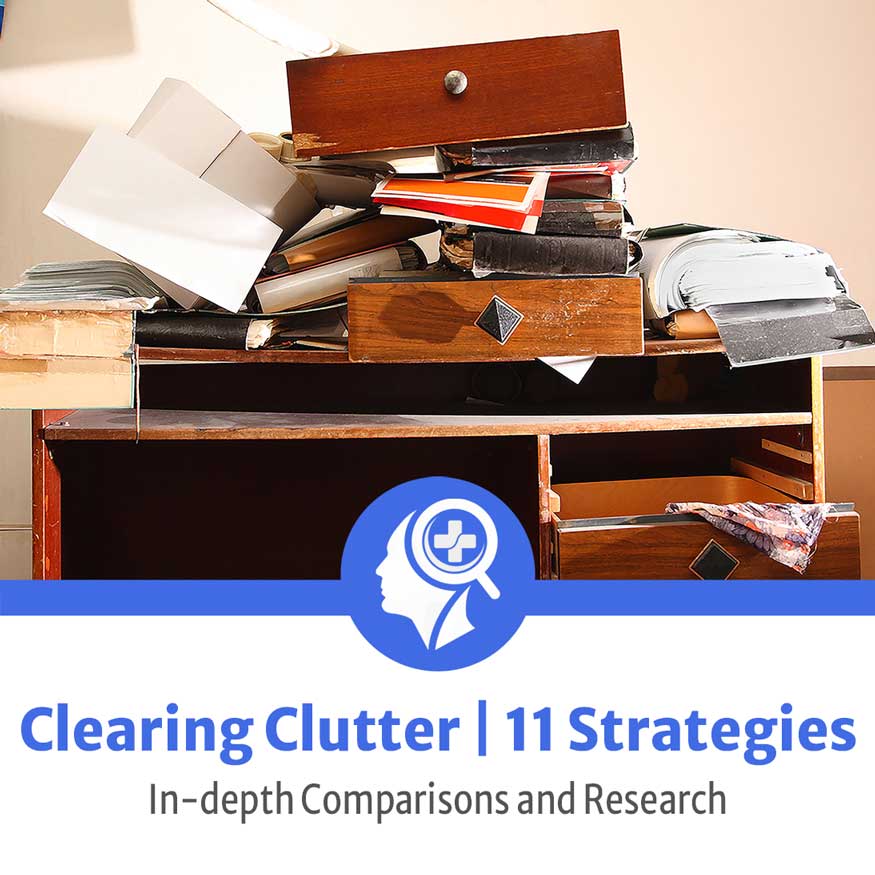
Getting a clutter-free home sounds daunting but isn’t as hard as one would imagine. Clearing clutter in your daily life can be super easy with the right attitude and some tools.
We at FinditHealth found that once you are used to living clutter-free, it becomes easier to maintain small, daily habits. Here are 11 strategies for better health and ways to clear the clutter in your home and keep it clutter-free over the long term.

What is Clutter?

Clutter is anything that you do not use regularly and is not adding value to your busy life. Decluttering projects are the act of removing these items and making room for the things that truly matter and bring value to your life.
For many people, clutter causes a lot of stress because you end up wasting a lot of time looking for things you can’t find. Research shows that most people agree that having unwanted clutter in the house makes them feel stressed and embarrassed.
Clutter can even cause health complications if mold and dust are present.
Why should you declutter for better health?
Organizing and decluttering relieves stress for many people by providing a sense of control and accomplishment. By getting rid of excess junk and clutter, you are freeing up extra space in your home that wasn’t there before. Whenever you are cleaning out your house before a move or just craving more organization, our guide will help. Keep reading for a list of 11 clutter-clearing strategies.
List Of 11 Clutter Clearing Strategies

1. Set a Timeline and Goals
It’s important to make a plan for clearing clutter before you get started and this gives you a fresh perspective on the project. Having specific goals will keep you on track and help reduce frustration and confusion.
A few things to consider are:
- Write down the main clutter spots or rooms you want to tackle and list them in order of messiness. This will help you prioritize your time and keep you on track and consider it a decluttering checklist.
- It’s important to only tackle one room or space at a time. An example would be a junk drawer or even to declutter one drawer by drawer in your desk drawer.
- Set dates and timelines for how long each room or spot decluttering will take. Make sure to give extra time for specific areas such as the basement or garage that will take longer than other areas in the home.
2. Try the trash-bag method.
This is a quick and easy way to start decluttering your home. Do a sweep of your house with a trash bag in hand and see how quickly you can fill the bag with clutter.
It’s a great, simple act that can be done weekly and helps you reduce clutter.
You will walk through and scan each room, grabbing anything that is garbage or no longer needed. Do this until you’ve made your way through the entire house. You can take the garbage bag to the actual garbage after or donation center.
3. Start Small
Please get rid of everything you don’t regularly use, organize the things you do, and commit to keeping it that way. In the future, notice the satisfaction you feel every time you open that drawer and also feel empowered by your new zen of cleanliness. This will motivate you to clean other areas of your house and start small.
We suggest starting with one small area of a room like a closet, cabinet, or dresser. Something that can be completed in under an hour.
4. Keep it sustainable
Keep it sustainable as in, don’t overwhelm yourself, so you stop after the first day. As we mentioned earlier, create a plan that works with your schedule and lifestyle. Tackle one small area or project at a time and practice keeping this space clutter free before you tackle the next project.
5. Use “habit tracking” to your advantage
It’s been shown through research that we have more success with habits and starting new things when we track. Like people wanting to lose weight are more successful when they write down what they eat versus winging it. When it comes to decluttering, set goals to help you stay accountable. For example, it could be to donate three items from your closet every month. Or tackle one new area of the house per month.
6. Don’t start with sentimental items
While decluttering, remember the goal is to have a purpose for every item you decide to keep. This can be very hard to decipher with sentimental items, and these are best saved for last. The more you practice decluttering, the more you will realize what items you need and value. As you grow through this process, you will have a deeper awareness of the value your items bring.
7. Create a home for everything
As we declutter, it’s important that we maintain an organizational system that is practical and realistic. You want to stay organized and maintain your clutter-free lifestyle long-term. As you declutter, make sure each item has a designated home and spot where it belongs.
8. Keep the one-in, one-out rule
This can be a great rule to abide by for clothes. Every time you buy a new top or pants, an old one must go out and be donated. This can also apply to the dish and bath towels and kitchen utensils. It’s a great way to keep things in check because so often, we buy things as an option for replacing something but never get rid of the old item.
9. Stop Buying More Things
On that note from the section above, a great way to reduce clutter is to stop buying more things. A lot of time, we buy things we don’t need because they were on sale or it was a gimmick we bought into. Once you start decluttering, we encourage you to actually not buy anything for a while. It’s a friendly reminder to go for a minimalist lifestyle approach and see what you really need and use in life. Think about items that you use almost every day versus items that are only used monthly or yearly. You want your item to have multiple purposes and functions in your life.
This can be challenging as we are faced with a lot of external factors like social media and marketing email campaigns that influence our buying decisions. A great way to keep this at bay is to organize your email account. We encourage you to unsubscribe from brand email lists so you will not be tempted by “20%” of sales.
10. Stay on Top of Your Mail
Mail is probably one of the biggest items of clutter in the average home. It generally just piles up in the corner for weeks, and the majority of it is garbage and paper waste. To prevent mail from piling up, deal with it as soon as you receive it. Create a filing or organization system that showcases mail that needs to be read, responded to, bill paid, and sent. You can also switch everything to paperless and receive email reminders instead. This would also be better for the environment.
11. Get the clutter out
Once you have decided something needs to go, it’s important to get rid of it as soon as possible. You don’t want it just turning back into more clutter sitting in your house or car! There are always a few options for getting rid of clutter, and we will highlight our favorites below.
- Donate: It’s always good to donate items in good shape to someone in your local community that needs them. We encourage you to research and find local charities in your area. Before dropping off donations, check the charity’s guidelines for accepted articles. You could also try posting to a Facebook resale group, and people in your area can come to get the items.
- Recycle: This is great for glass, plastics, and paper that you found as you went into the decluttering process. Use your neighborhood recycle bin on the curbside or take it to your nearest recycling drop-off location.
Garbage Sale: This can be a daunting task but allows you to make some money off your clutter by selling to your neighborhoods. Start advertising a week in advance by posting signs around the neighborhood and even in local restaurants and coffee shops.
Conclusion – Research by Findithealth.com


While decluttering isn’t easy, researchers at Findithealth found that the results are well worth it. Research shows that having a clutter-free home does lead to less stress and more time for things you enjoy.
Celebrate your successes no matter how small, and focus on how good it feels to live with less stuff and clutter-free home.

